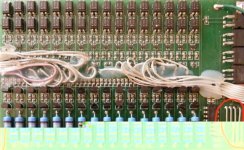I use ExpressPCB, and their service is fast and accurate. The free software has been flawless. I will be happy to pass on the existing PCB files to whoever wants them, but it is going to need some major surgery, I think. The best option I can see is to use randomly's circuit mod for the charger control section, which keeps the shunts right at the cutoff point, and so this should drastically reduce the heat generated by the TIP105 power transistors. I'd also change the LVC active cutoff portion of the circuit to what randomly proposed, but I'd still use the opto outputs, It is simpler and cheaper this way, plus it works.

The other thing that needs changing is to add the LEDs back in, for each channel, if that is desired. The last version of the layout I did (v1.14...) had those removed. The board will have to be slightly wider, but it is not such a big deal to put them back in. Personally, I question their usefulness, but others like lots of lights I guess.

On another front, I finally got some time to do some testing with my switched capacitor prototype balancer. The main part doing most of the work is the LM2663 SMD, along with a 10uF multi-layered ceramic cap. The rest is just a couple of op-amps which are used to drive a two-color LED. When one cell is significantly above the cell adjacent to it, the LED is either fully red or fully green. If the cells are reasonably balanced, both colors are lit, and the color is yellowish. In the picture below, I've populated enugh of the board to do three cells. There are three a123 cells connected, with two of the cells fairly close, and one that is quite a bit lower:

So far, it appears to be working, and the cells are balancing. I don't know how long it will take just yet. The chip/cap combo is able to move a max of about 200mA between cells. The little LM2663 parts are definitely warm, but not too hot that you can't leave your finger on them. Anyway, this will be an interesting test. If it works, and the cells balance in a reasonable enough time (couple of hours for a 10Ah pack...), I will go ahead and make a complete balancer. I've also figured that I could turn this into a BMS by adding the LVC portion, plus some logic to put the LM2663 chips in the sleep mode unless the charger is connected, and if the cells are all above the LVC set point. Way too early for that, though, as I still don't know how well this will work.
For those looking at Ping's BMS board, richard had a suggestion in the other thread that you could up the current limit by filling in the shunt resistors with some solder. I think it is better to simply bypass both the current limiter and the LVC active cutoff, and just tie the existing cutoff logic into the controller ebrake line, as suggested. Shouldn't be that hard. The balancer portion only disappates about 50mW per channel, so plan on leaving the charger connected for a day, or so, if you are lookig to balance a big capacity pack (30-40 Ah...).
-- Gary




